Introduction
The Roman Empire came to be as a result of the ancient roman civilization, with diplomatic governments and enormous territorial wealth in Europe and some parts of Africa. The Empire had a long and rich entertainment history that’s evident in its various entertainment venues; it was a part of daily in Rome and its provinces, even one Roman poet Juvenal (100 AD) noted in his poems that only two things mattered most to the Romans “bread and circuses” (panem et circenses) meaning bread and games.
The rulers used entertainment to satisfy common Roman’s mere needs by giving free entertainment and bread to keep them happy and unaware of the governance in the Roman Empire and a simple way to become more powerful. The following analysis will focus on these Roman Empire entertainment venues and their roles in the Roman Empire.
Theaters
Most Roman Empire ceremonies and events took place in temporary wooden structures. The first such theater was ordered constructed by Pompey in 55 BC on the Campus Martius at Rome. Built on level ground, it had a capacity of 27000 seats and was built of stone (see fig.1). Theaters hosted choral events, plays and written material narration.
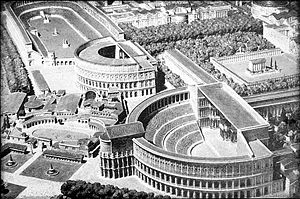
Theaters were constructed anywhere, on flat plains, by building the whole structure from the ground and out of the sides of hills. All were built of Roman concrete and had a circular space in front popularly known as an orchestra, where performances took place (see fig.2). The structure was more complex and entrances and exits were built into a cave as it is in large theaters today. It created an enclosed atmosphere that may have reduced noise from other places (Beacham 200).
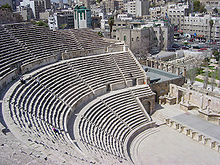
The theaters were free to the public and as a result the audiences were huge in numbers and noisy at times. To make it easier for the audience to understand the plays, costumes and masks were introduced to show the type of person on stage. To distinguish between males and females in an act, the male was recognizable by a brown mask while the female was recognizable by white mask. Other masks worn resembled various emotions depending on the act, like happy, sad, and angry. The women didn’t take part in any performance or act. Performers spoke the actual act lines while a second performer translated the lines through signs as music was being played. Decorated masks and costumes were to make the performances more interesting.
Most of the plays, dancing, and other presentations were associated with important occasions and religious festivals; eventually they were very popular in the Roman Empire and became common rather than on special occasions. The plays were their own playwrights or borrowed from the Greeks and most of the actors were slaves because it wasn’t a respectable job amongst the Romans.
The theaters had no seats and only those who came with their seats sat the rest remained standing or sat on the ground. Women and men were separated, women were placed in the worst places and the best places sat the nobles of the Roman Empire. Children were also in attendance with their mothers; and were very emotional and expressing any reactions from the plays and presentations.
Amphitheaters
The name amphitheater means double theater, which originated from its shape that resembles that of two theaters joined back to back, with a central space referred to as “arena” (see fig.3). The sand was scattered on the arena to drench blood spilled from bloody games. The first amphitheater was built by one of the architects of the great politician Curio in 53 BC (Borngardener 34). It was built of wooden stands on a pivot and swiveled about to form an oval shape. The amphitheaters were used for games, spectator sports, displays and other public events, such as criminal execution and forced fights that led to death as Gladiators.
To the Roman Empire the amphitheater held vital symbolic significance. The seating arrangements represented the various classes of the Roman Society. A special area on a large platform was for the Emperor and senators occupied marble seats divided into fourteen subdivisions. At the lower level of the amphitheater were twelve rows were associates of the equestrian class occupied. Next were well-off or reputable Romans who occupied nineteen sections of marble chairs in the center area, while the ordinary, slaves and freed slaves occupied the top seating area. Finally at the peak of the amphitheaters, wives of the noble and rulers occupied wooden chairs shaded by colonnade.
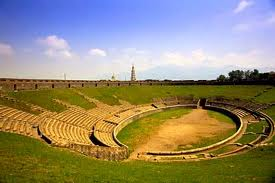
The amphitheater was a defining feature of the Roman Empire civilization where many events portrayed the vast Roman dominion. The gladiators were the main attraction in the amphitheaters. They were either slaves or volunteers who were made to fight to death, staged by the rich as a sign of their power and influence in the local community. Gladiator paintings are still evident at the Pompeii amphitheater specially crafted into walls by professional painters (Borngardener 36). The gladiators originated from the Etruscan funeral ceremonies but as the Empire grew such ancient ceremonies were no more.
Other than gladiatorial games, the amphitheater gave a venue for venations, spectacle involving killing animals by trained hunters known as bestiaries. Public execution was also a spectacle, where condemned criminals were executed by cremation, crucifixion, and attacked by wild animals.
Smaller towns in the provinces built one amphitheater, which was the only venue for most of their entertainment. Eventually they were huge in size so as to accommodate the massive audiences attending and were built on the edge of the towns or just outside its boundaries. The military built their amphitheaters on forts and fortresses which served as training venues for the soldiers.
Circuses
The Roman circus used to be huge open-air location used for mainly communal events and festivals in the Roman Empire. The first circus in the Roman Empire was the Circus Maximus, which was a venue for games and mass entertainment with a capacity of 250000 audiences (Humphrey, 57). Circuses were one of the main amusement venues of the time where horse races, chariot races and main performances of the empire took place.
The major performance area of the Roman extravaganza was a rhombus rectangle of two linear parts of a racing track alienated by a middle strip along the middle of the space, and capping at each end with two curved parts linking the linear sections forming a course for racing (see fig.4) (Humphrey, 59). The mid strip was referred to as the spina that had complex columns, statues, and memorial obelisks (piercing pillar). Just like amphitheaters, the circus performance area was surrounded by an ascending seating position. The circuses are believed to be the biggest entertainment venues in the Roman Empire which were like the modern-day stadiums, some covering over 200 acres of land.
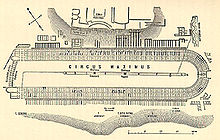
The circus paid a host to various circus games (ludi circenses), like athletics and wrestling, eventually chariot racing remained the favorite sport among the citizens in the Roman Empire. Being a sport it was very expensive since it required horses that were expensive at that time, but was organized into a very profitable business. The charioteers were subdivided into four groups recognizable by their different colors, blue, white, green, and red which represented the different provinces of the Roman Empire. Reds were the architects and engineers, the greens were farmers, blues were the fishers or from near the sea, and whites were from snowy mountains (see fig.5).
The four factions contested greatly, to an extent of causing violence among audiences and supporters, however greens and blues were the best and favorites. The ruling senators took advantage of the races to showcase their dominion and gain power and popularity among the Romans.The circus also provided a good chance to make money among the wealthy by placing bets on racers on who would win.
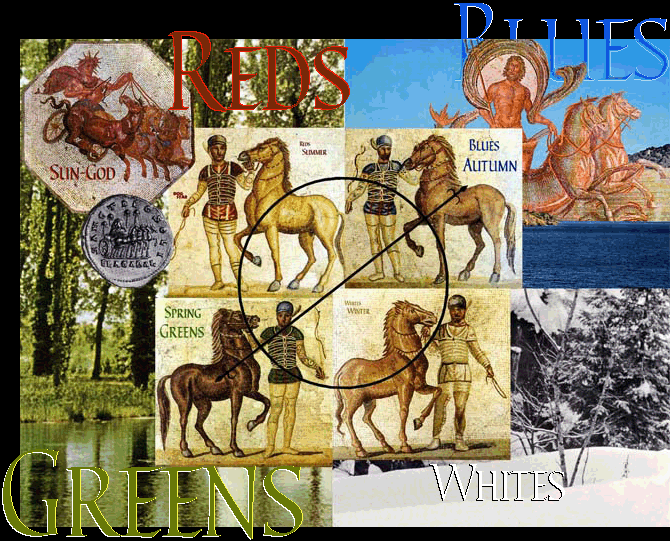
The circus was an all-in-one political, unions, gambling, and sports and entertainment industry, where all Rome attended. It was a fantastic spectacle, parades and processions of leaders, kings, gods and goddesses, exotic and tamed animal acrobats showcased that built energy for the races; sellers of every food and drink and flags decorations over racers while their supporters dodged death on the racing path (Humphrey 64).
Everybody was allowed in the circus except for the children and all were allowed to sit together. In times of victory the rulers had the games played for even a fortnight making the circus a very important entertainment venue for the Roman Empire.
Baths
The public Roman Empire baths (thermae) were designed along an inner axis which included a hot bath (caldarium), a warm bath smaller in size (tepidarium), the cold bath (basilica), and an outdoor bathing bath or pool (natatio) (Potter 20). Besides the Roman public baths a series of rooms were built for various purposes, such as a massage house, a room for changing clothes, a room for exercise, and a special room for medical treatment (see fig.6). such baths are still standing up to now, such as the Caracalla. Bathers started at the changing rooms (apodyteria), then to the gymnasia (palaestra) for exercise and then to a sauna (laconic) to stimulate more sweat. Bathers then proceeded to the hot bath where they cleaned their skin using a strigil and finally to the cold bath(Potter 23).
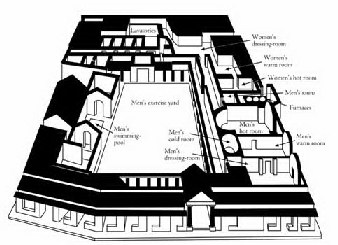
The bath was mostly taken once a day and stood for decency and health only. Their origin came from the highly populated towns where civilians of the Roman Empire were populated and mostly lived in small and congested apartments that didn’t have any bathing space. The baths were mostly built on hot or mineral springs and operated in all parts of Rome and in the provinces. The baths weren’t free, but a low fee was charged so even the poor could visit. The baths were also meant for leisure, social gatherings and sheltered gardens, libraries, and museums. Complimenting the magnificent havens were marble statues and artistic structures.
The Roman architects improvised a local heating system for the baths; the floor was put up from the earth by pillars and spaces left in the walls to enable hot air from the heating system (furnace) circulate. The rooms needing more heat were near the heating system, where heat was generated from burning wood. The baths also had large toilets made of marble seats over a canal filled with flowing water that constituted what’s today known as flush toilets.
Leisure Activities
The Roman Empire entertainment was evident from the information above, but as time went on the games increasingly started ending. However for the rich and noble civilians of the Roman Empire, entertainment took place in their homes. They hosted dinner parties and expensive banquets. While dining music, dancing, and signing were presented by professionals and in some homes recitation of speeches and poetry followed.
For the majority of the poor Romans, entertainment meant visiting the taverns which are the modern-day bars and inns where food, beverages, and alcohol were sold. Other venues for their entertainment were brothels and gaming houses. Brothels were also referred to as gentleman’s club, which was houses meant for prostitution only. The children also had their traditional games like hiding and seek which are evident in Roman Empire art (Potter 30).
Works Cited
Beacham, Richard C. The Roman Theater and its Audience Washington DC, Washington: 1991. Print.
Borngardener, David. The story of the Roman amphitheatre London: Routledge, 2002. Print.
Humphrey, John. Roman circuses: arenas for chariot racing. Berkeley, CA: University of California Press, 1986. Print.
Potter, David. Companion to the Roman Empire. Oxford: Blackwell, 2010. Print.